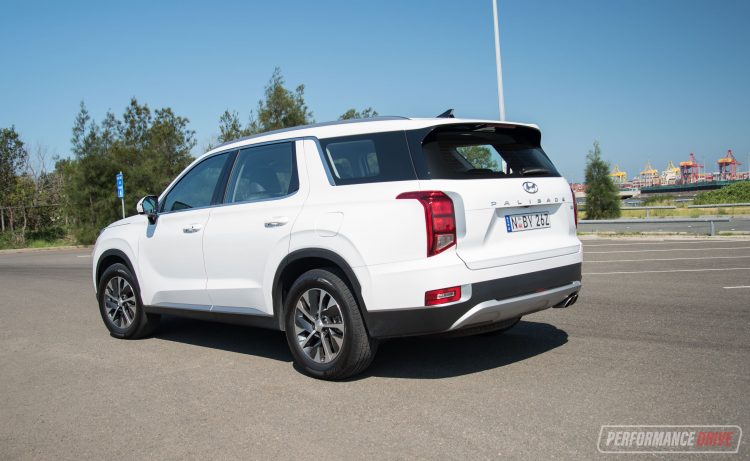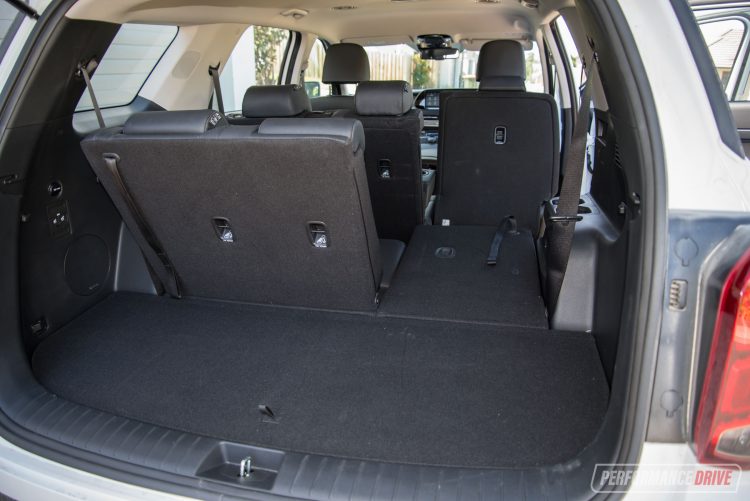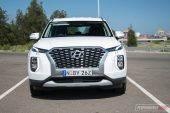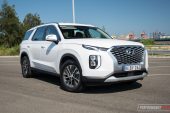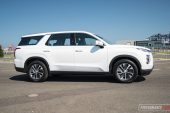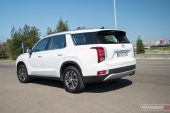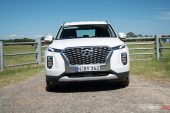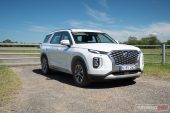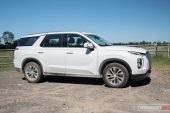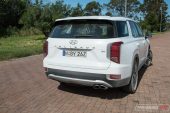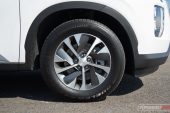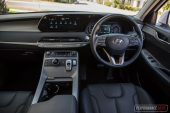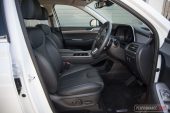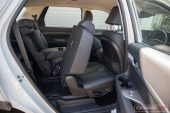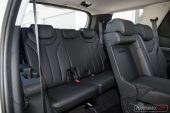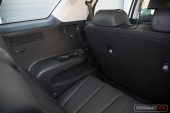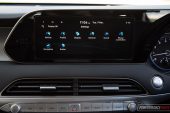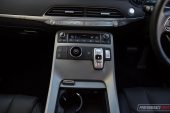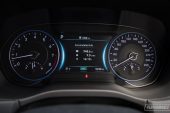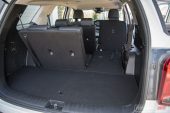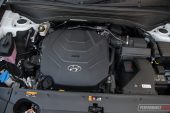‘Big’ must have been the one word Hyundai bosses emphasised to their designers when it came to the development of its largest SUV yet, the Hyundai Palisade. It is huge. Originally developed to appeal to the American market, it has now reached Australian shores, two years later.
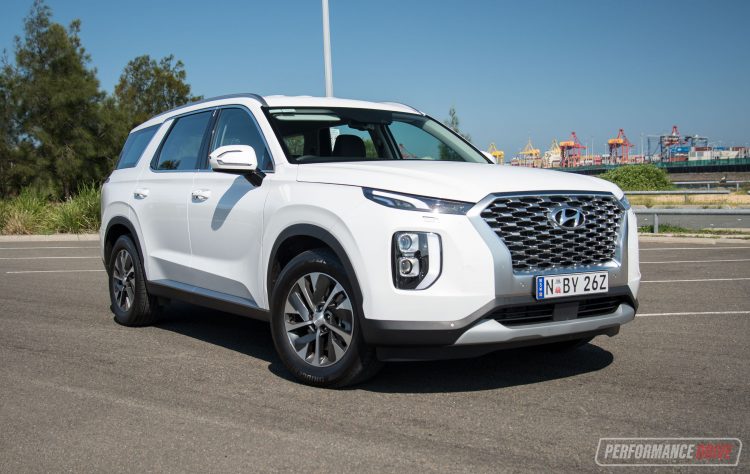
There are only three other SUVs on sale in Australia that offer eight seats; the Toyota LandCruiser, Lexus LX, and the Nissan Patrol. But as we know, those SUVs are engineered as quite hardcore and heavy-duty off-road vehicles, featuring a full ladder-style chassis. So, it will be interesting to see if the Hyundai Palisade will thrive without such off road capabilities.
The Palisade is built on a stretched version of the Santa Fe‘s platform. Australian buyers get to choose from the no-named Palisade base version or the top Highlander. Both variants are available with a front-wheel drive 3.8-litre petrol V6 that unleashes a hefty 217kW and 355Nm, or an all-wheel drive 2.2-litre turbo-diesel that churns out 147kW and 440Nm. Both power systems are paired with an eight-speed automatic transmission.
Today, we’re putting the base Palisade with the petrol V6 through its paces. Prices commence at $60,000 for our variant and rise to $74,000 for the diesel Highlander (excluding on-road costs).
2021 Hyundai Palisade V6 – THE SPECS
[column width=”47%” padding=”6%”]Engine: 3.8-litre petrol V6
Output: 217kW@6000rpm / 355Nm@5200rpm
Transmission: Eight-speed auto
Drive type: Front-wheel drive
Wheels: F & R: 18×7.5, 245/60
ANCAP: Not tested
Tare weight: 1861kg
Power-to-weight: 8.57:1 (kg:kW)
Official fuel economy: 10.7L/100km
Economy during test: 10.8L/100km
Fuel capacity/Type: 71L/91 RON[/column] [column width=”47%” padding=”0″]Power efficiency: 20.28kW:L/100km
0-60km/h: 3.99 seconds*
0-100km/h: 8.01 seconds*
60-110km/h: 5.10 seconds*
1/4 mile: 15.85 seconds at 149.7km/h*
Max acceleration: 0.656g
100-0km/h braking: 3.23 seconds at 42.03 metres*
Max deceleration: -1.050g
Decibel at idle: 41*
Peak decibel at 60-100km/h: 79*
Priced from: $60,00[/column][end_columns]
* Figures as tested by PerformanceDrive on the day. Factory claims may be different
2021 Hyundai Palisade V6 – THE PACKAGE
The Palisade’s sheer road presence is emphasised by its exterior design. Americans like their cars big and prominent. At the front there is a huge wafer grille exaggerated by a silver surround that covers the tall frontal surface. Like the Kona, there are upper and lower headlight units. They are wrapped by a ribbon of LED lighting that looks striking during the day and night.
Across the bonnet and through to the rear are ribbed contours that cast stark shadows. The design at the rear is a little different from what we have seen from Hyundai. It goes with narrower and bulged taillights that are accented with chrome. Although the overall design is not overly modern, it gives off a dominant and powerful look more than anything else.
Not only is its size conveyed in the design, it is only 10mm shorter and 5mm narrower than a LandCruiser. So, it is no surprise how roomy the interior is. The centre console rises to your arm’s height, so you don’t have to reach far to press all the buttons. Tall drivers still leave plenty of legroom in the back for tall rear passengers. We found wider passengers are also left with wriggle room when all seats are occupied. For a third row, there is an incredible amount of space legroom-wise, but it starts to become a little narrow for three adults across the back, especially on longer trips.
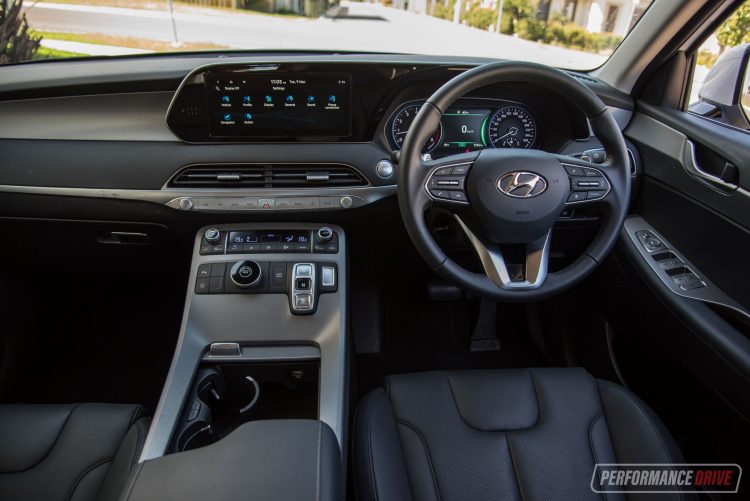
Even with all three rows in use, the Palisade offers ample boot space. At 311 litres, this is more than what you get from a Toyota Corolla hatch. With the second row folded away, the space expands to an impressive 704 litres. With both rear rows down you have 1297L. Although the way manufacturers measure boot sizes can vary, this tank is officially more capacious than the LandCruiser’s 1276-litre boot. If you can’t fit something into the Palisade on a camping trip, you must be taking the kitchen sink.
Comfort levels have obviously been meticulously considered, as finding your groove in the pilot seat is easy. The seats are large, but not overly bolstered, so you don’t feel hemmed in if you have a bigger body shape. The trade-off though is that you’re not firmly held in during faster cornering. For those that like to feel high on the road, you definitely get that sensation in the Palisade – and even though it’s a big SUV, you get decent vision around you so it’s easy to park and place on the road.
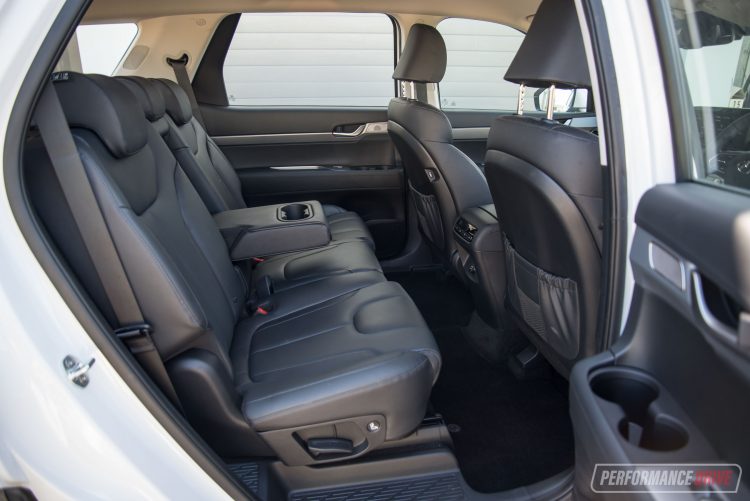
The interior design and presentation in the Palisade is not the latest or best we’ve seen from Hyundai – especially when you compare it to the funky Tucson and new Santa Fe. That’s because this Palisade has been out for a couple of years now. This interior is made up of dark grey and black, which looks a little aged. A lighter colour package is available. There is a large amount of textured silver trim, and there are plenty of soft-touch materials. But there is no digital instrument cluster or glossy black elements to provide that fashionable, futuristic vibe.
All Palisade variants are well-appointed. You receive a brilliant 12-speaker stereo with sat-nav, Android Auto and Apple CarPlay, multi-zone climate control with vents for all rows, leather seats, proximity keyless locking, front and rear parking sensors, distance-controlled cruise control, electric driver’s seat, gear shift paddles, auto dipping high beam, puddle lamps, tyre pressure monitoring, and a full-size spare wheel. You are also looked after in the safety department with blind-spot sensors, lane departure warning with active assist, forward and reverse collision mitigation with pedestrian avoidance, and rear cross-traffic alert.

Only when you opt for the Highlander you score electric level-adjusting headlamps, heated and ventilated front and second row seats, a heated steering wheel, head-up information display, upgraded Nappa leather seats, a powered tailgate, rain-sensing wipers, side door exit warning, a dual pane electric sunroof, and wireless phone charging capability.
Hyundai offers a trendsetting and magnificent five-year, unlimited kilometre warranty. Servicing is required every 15,000km or 12 months.
2021 Hyundai Palisade V6 – THE DRIVE
Hauling a 1900kg SUV is a big task. But the 3.8-litre naturally aspirated V6 has no trouble in gaining momentum quickly. The 217kW engine is happy to rev up with enthusiasm to get the job done. And it needs to as 355Nm of torque is not a huge figure for a big SUV like the Palisade. Going up hills tends to prompt a downshift of a few gears pretty quickly as the top end of the rev range is where all the magic happens. Our 0-100km/h test revealed a best time of 8.01 seconds.
What also helps the Palisade move along is the faultless eight-speed auto transmission. It is very smooth and unruffled. It lines up the right gear without delay, even under heavy acceleration. Usually, smooth gear shifting means delays and diminished acceleration. Not here.

Being a higher-revving engine and a huge 3.8 litres in capacity means the fuel figures are a notable pitfall in the V6 option. The official average consumption is listed at 10.7L/100km. This can be achieved in the real world if most of your driving is done on the freeway. Although, our average dropped to 8.7L/100km on a big highway trip. But when the environment changes from freeways to suburban streets, the overall average climbs to around 10.8L/100km. Frankly, this figure is not good enough by today’s standards. Even for something with 217kW. Some redemption is made by the fact that it can run on the most affordable 91 RON and E10 fuels.
If you’re specifically in the market for an SUV with a decent towing capacity, this Hyundai will disappoint. At 2200kg (braked), it falls short of 3500kg seen in the Land Rover Discovery and Toyota LandCruiser.
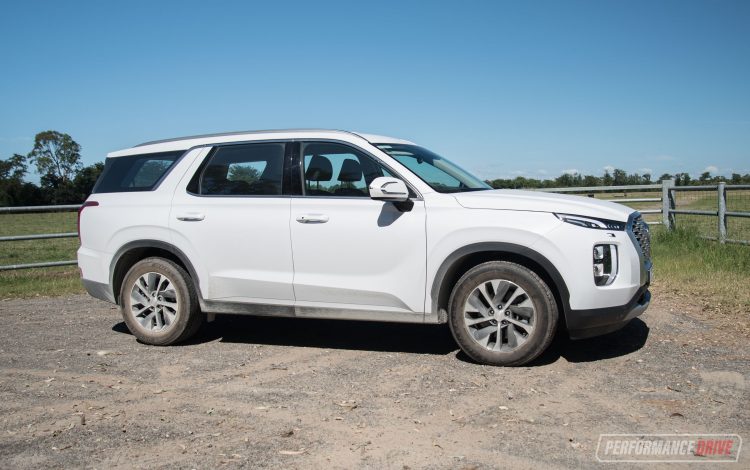
The Palisade is not designed for hardcore off-road adventures. But it will easily satisfy most drivers’ needs for camping trips or country dirt road tours. Being a front-wheel drive in petrol form means traction suffers on slippery bends and dirt roads. You need to contend with a lot of wheelspin and torque-steer from all that power, too. The only added benefit it has over a regular sedan is extra ground clearance. In that sense, the all-wheel drive diesel model is clearly a worthy upgrade.
In terms of suspension dynamics, the Palisade offers a great balance of not being too soft for cornering, while not too hard for absorbing bumps. Hyundai has found a superb middle ground. It also offers excellent stability over larger bumps, with no bump-steer or major tramlining. And even though the Palisade is a big SUV, it doesn’t at all feel as big as it is. It’s planted and committed, even when pushed relatively hard through bends. The appropriately-weighted steering also helps to support fun driving experiences, conveying good feel for the road ahead and ideal response and accuracy for this style of vehicle.
2021 Hyundai Palisade V6 – THE VIDEO
2021 Hyundai Palisade V6 – THE VERDICT
For those in the market for one of the biggest SUVs you can buy, the Hyundai Palisade is definitely worth a look. It is especially attractive if you need eight seats and don’t really need off-road capabilities. You get a long list of standard features and safety tech, and a boot size big enough to swing a cat.
But it loses points on its old-fashioned, large V6 petrol engine that burns too much fuel (it’s also 2WD only). Luckily there is a diesel alternative on offer. Its design is also starting to look dated due to the fact this model is technically already at its mid-life overseas.
[column width=”47%” padding=”6%”]PROS:
– Huge amount of space inside, eight seats
– Lots of important safety technology and features as standard
– Easy to drive and manage, considering its sheer size
– Composed dynamics and ride quality[/column] [column width=”47%” padding=”0″]CONS:
– Guzzling petrol V6 engine doesn’t make sense here, diesel the pick
– Design inside and out is not the latest from Hyundai
– No digital instrument cluster[/column][end_columns]
As always, if you’re thinking about buying a new car don’t forget to click here to speak with our car buying specialists.
